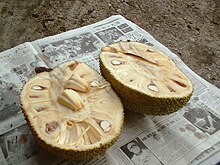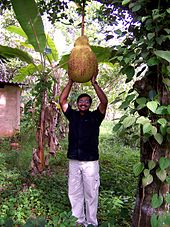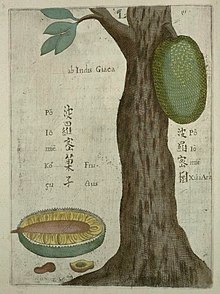Jackfruit: Difference between revisions
Tag: repeating characters |
|||
| Line 25: | Line 25: | ||
It is well suited to tropical [[lowland]]s. Its fruit is the largest tree-borne [[fruit]] in the world,<ref>{{cite web|url= http://www.proscitech.com.au/trop/j.htm |title= Jackfruit, Breadfruit & Relatives |accessdate=2010-06-21}}</ref> reaching {{convert|80|lb}} in weight and up to {{convert|36|in|cm|-1}} long and {{convert|20|in|cm|-1}} in diameter.<ref>{{cite web|title= Jackfruit |url= http://www.crfg.org/pubs/ff/jackfruit.html |accessdate=2010-06-21}}</ref> |
It is well suited to tropical [[lowland]]s. Its fruit is the largest tree-borne [[fruit]] in the world,<ref>{{cite web|url= http://www.proscitech.com.au/trop/j.htm |title= Jackfruit, Breadfruit & Relatives |accessdate=2010-06-21}}</ref> reaching {{convert|80|lb}} in weight and up to {{convert|36|in|cm|-1}} long and {{convert|20|in|cm|-1}} in diameter.<ref>{{cite web|title= Jackfruit |url= http://www.crfg.org/pubs/ff/jackfruit.html |accessdate=2010-06-21}}</ref> |
||
boner,boner,boner,boner,boner,boner,boner,boner,boner,boner,boner,boner,boner,boner,boner,boner,boner,boner,boner,boner,boner,boner,boner,boner,boner,boner,boner,boner,boner,boner,boner,boner,boner,boner, |
|||
==Etymology and names== |
|||
The name "Jack fruit" is derived from the [[Portuguese language|Portuguese]] ''Jaca'',<ref>{{cite dictionary|url= http://www.merriam-webster.com/dictionary/jackfruits |encyclopedia= merriam-webster.com |title=jackfruits |accessdate=2010-06-21}}</ref> which in turn, is derived from the [[Malayalam]] language term, ''Chakka''.<ref name=malayalam>T. Pradeepkumar, Kumar, Pradeep. [http://books.google.com/books?id=UuCWMJjOvYUC&pg=PA81&dq=jackfruit+Chakka ''Management of Horticultural Crops: Vol.11 Horticulture Science Series''], page 81: "The English name jackfruit is derived from Portuguese jaca, which is derived from Malayalam chakka."</ref> The [[Portuguese people|Portuguese]] first arrived in [[India]] at [[Kozhikode]] ([[Calicut]]) on the [[Malabar Coast]] ([[Kerala]]) in 1498. The Malayalam name ''Chakka'' was recorded by [[Hendrik van Rheede]] (1678–1703) in the ''[[Hortus Malabaricus]]'', vol. iii in [[Latin]]. [[Henry Yule]] translated the book in [[Jordanus|Jordanus Catalani]]'s (1678–1703) ''Mirabilia Descripta: The Wonders of the East''.<ref>http://www.archive.org/stream/mirabiliadescrip00jord#page/12/mode/2up</ref> |
|||
The fruit is called a variety of names around the world. The common English name ''jackfruit'' is a name used by the physician and naturalist [[Garcia de Orta]] in his 1563 book ''[[Colóquios dos simples e drogas da India]]''.<ref name=oed>''Oxford English Dictionary'', Second Edition, 1989, online edition</ref><ref>Anon. (2000) [http://www.bartleby.com/61/33/J0003300.html The American Heritage Dictionary of the English Language: Fourth Edition.]</ref> A botanist, [[Ralph Randles Stewart]] suggests that it was named after [[William Jack (botanist)|William Jack]] (1795–1822), a Scottish botanist who worked for the East India Company in Bengal, Sumatra and Malaysia.<ref>"How Did They Die?", [[Ralph Randles Stewart|Ralph R Stewart]], ''Taxon'' 33(1):48-52, 1984</ref> This is unlikely, as the fruit was called a "Jack" in English before William Jack was born: for instance, in [[William Dampier|Dampier]]'s 1699 book, ''A new voyage round the world''.<ref>"The jack or jaca is much like the durian, both in bigness and shape", ''A new voyage round the world'', William Dampier, 1699, [http://books.google.com/books?id=adsNAAAAQAAJ&pg=RA2-PA320&dq=%22Jack+or+Jaca+is+much+like+the+Durian%22&lr=&as_brr=0&as_pt=ALLTYPES p320]</ref>. |
|||
==Cultivation and ecology== |
==Cultivation and ecology== |
||
Revision as of 20:55, 18 January 2011
| Jackfruit | |
|---|---|

| |
| Jackfruit tree with fruit | |
| Scientific classification | |
| Kingdom: | |
| Division: | |
| Class: | |
| Order: | |
| Family: | |
| Tribe: | |
| Genus: | |
| Species: | A. heterophyllus
|
| Binomial name | |
| Artocarpus heterophyllus | |
| Synonyms | |
The jackfruit (Artocarpus heterophyllus or A. heterophylla[1]) is a species of tree in the mulberry family (Moraceae), which is native to parts of Southern and Southeast Asia. It is the national fruit of Bangladesh. Jackfruit is also found in East Africa e.g. in Uganda, as well as Northeastern Brazil.
It is well suited to tropical lowlands. Its fruit is the largest tree-borne fruit in the world,[2] reaching 80 pounds (36 kg) in weight and up to 36 inches (90 cm) long and 20 inches (50 cm) in diameter.[3]
boner,boner,boner,boner,boner,boner,boner,boner,boner,boner,boner,boner,boner,boner,boner,boner,boner,boner,boner,boner,boner,boner,boner,boner,boner,boner,boner,boner,boner,boner,boner,boner,boner,boner,
Cultivation and ecology

The jackfruit has played a significant role in Indian agriculture for centuries. Archeological findings in India have revealed that jackfruit was cultivated in India 3000 to 6000 years ago. Findings also indicate that Indian Emperor Ashoka the Great (274–237 BC) encouraged arbori-horticulture of various fruits including jackfruit. Varahamihira, the Indian astronomer, mathematician, and astrologer, wrote a chapter on the treatment of trees in his Brhat Samhita. His treatise includes a specific reference on grafting to be performed on trees such as jackfruit.[4] Maturing in 35-40 years, their wood can be used for furniture. The gum from this tree is used to repair small holes in pots. In Kerala (India), Jackfruit tree supports the Black Pepper vine, which is a climber. Thus the trunks of Jackfruit trees of Kerala are usually covered with the dark green leaves of the pepper vine cultivated by the farmers.

The jackfruit is considered an invasive species in Brazil, especially in the Tijuca Forest National Park in Rio de Janeiro. The Tijuca forest is mostly an artificial secondary forest, whose planting began during the mid-nineteenth century, and jackfruit trees have been a part of the park's flora since its founding. Recently, the species expanded excessively, due to the fact that its fruits, once they had naturally fallen to the ground and opened, were eagerly eaten by small mammals such as the common marmoset and the coati. The seeds are dispersed by these animals, which allows the jackfruit to compete for space with native tree-species. Additionally, as the marmoset and coati also prey opportunistically on bird's eggs and nestlings, the supply of jackfruit as a ready source of food has allowed them to expand their populations, which has negatively impacted the local bird population. Between 2002 and 2007, 55,662 jackfruit saplings were destroyed in the Tijuca Forest area in a deliberate culling effort by the park's management.[5]
Commercial availability
Outside of its countries of origin, fresh jackfruit can be found at Asian food markets especially in Philippines. It is also extensively cultivated in the Brazilian coastal region, where it is sold in local markets. It is available canned in sugar syrup, or frozen. Dried jackfruit chips are produced by various manufacturers. In northern Australia, particularly in Darwin, Australia, jackfruit can be found at outdoor produce markets during the dry season. Outside of countries where it is grown, jackfruit can be obtained year-round both canned or dried. It has a ripening season in Asia of late Spring to late Summer.[6]

Jackfruit
The flesh of the jackfruit is starchy, fibrous and is a source of dietary fiber. The flavour is similar to a tart banana. Varieties of jackfruit are distinguished according to the characteristics of the fruits' flesh. In Brazil, three varieties are recognized. These are: jaca-dura, or "hard" variety, which has firm flesh and the largest fruits that can weigh between 15 and 40 kilograms each; jaca-mole, or "soft" variety, which bears smaller fruits, with softer and sweeter flesh; and jaca-manteiga, or "butter" variety, which bears sweet fruits, whose flesh has a consistency intermediate between the "hard" and "soft" varieties.[7]
In Kerala, mainly two varieties of Jackfruit are found: Varikka and Kuzha. Varikka has slightly hard flesh for the inner fruit when it becomes ripened. Kuzha fruit has very soft, almost dissolving type flesh for the inner fruit on ripening. A sweet preparation called Chakka Varattiyathu is made by seasoning the Varikka fruit flesh pieces in jaggery, which can be preserved and used for many months. Huge jackfruits up to 4 feet length with matching girth are sometimes seen in Kerala.
Dishes and preparations

Jackfruit is commonly used in South and Southeast Asian cuisines.[8] It can be eaten unripe (young) when cooked, or ripe uncooked.[8] The seeds may be boiled or baked like beans. The leaves are used as a wrapping for steamed idlis.
Young fruit
The young fruit is called Polos in Sri Lanka, and 'Idichakka" in Kerala. It is a wonderful dish with spices to replace meat curries in Sri Lankan cuisine. The skin of unripe (young) jack fruit must be pared first and discarded and then the whole fruit can be chopped into edible portions and cooked to be eaten. The raw young fruit is not edible.[8] Young jackfruit has a mild flavour and distinctive texture. The cuisines of India, Nepal, Bangladesh, Sri Lanka, Indonesia, Cambodia, and Vietnam use cooked young jackfruit.[8] In Indonesia, young jackfruit is eaten as gudeg. In many cultures, jackfruit is boiled and used in curries as a staple food.

Jackfruit is a part of Telugu culture as well. In Andhra, jackfruit is a delicacy. It is called "Panasa pottu koora", or finely chopped jackfruit curry. It is mixed with mustard and cooked, and is a popular Telugu dish.
Seed of ripen fruit
Fresh seed of the ripen Jackfruit can be eaten after boiling in hot water. The boiled seed taste like nut and this way of cooking is common in the South-east Asia.
Wood
The wood of the tree is used for the production of musical instruments. In Indonesia it forms part of the gamelan and in the Philippines, its soft wood is made into the hull of a kutiyapi, a type of Philippine boat lute. It is also used to make the body of the Indian string instrument Veena and the drums Mridangam and Kanjira, the Golden yellow coloured timber with good grains is used for building furniture and house construction in India. The ornated wooden plank called Avani Palaka made of the wood of Jackfruit tree is used as the priest's seat during Hindu ceremonies in Kerala.
Jackfruit wood is widely used in the manufacture of furniture, doors and windows, and in roof construction.
The heartwood of the jackfruit tree is used by Buddhist forest monastics in Southeast Asia as a dye, giving the robes of the monks in those traditions their distinctive light brown color.[9]
Cultural significance
The Jackfruit is one of the three auspicious fruits of Tamil Nadu, along with mango and banana.[10]
See also
- Breadfruit (Artocarpus altilis)
- Cempedak (Artocarpus champeden)
- Marang (Artocarpus odoratissimus)
- Durian, an unrelated fruit similar in appearance
- Fig (Ficus carica)
- List of fruits
References
- ^ "Artocarpus heterophyllus". 2006-10. Retrieved 2010-06-21.
{{cite web}}: Check date values in:|date=(help) - ^ "Jackfruit, Breadfruit & Relatives". Retrieved 2010-06-21.
- ^ "Jackfruit". Retrieved 2010-06-21.
- ^ Science in India with Special Reference to Agriculture P.M. Tamboli and Y.L. Nene
- ^ Livia de Almeida, "Guerra contra as jaqueiras" ("War on Jackfruit"), Revista Veja Rio, May the 5th.2007; see also [1]
- ^ http://www.hort.purdue.edu/newcrop/morton/jackfruit_ars.html#Season
- ^ [2] General information, Department of Agriculture, State of Bahia
- ^ a b c d The encyclopedia of fruit & nuts, By Jules Janick, Robert E. Paull, pp.481-485
- ^ Forest Monks and the Nation-state: An Anthropological and Historical Study in Northeast Thailand J.L. Taylor 1993 p218
- ^ Subrahmanian N, Hikosaka S, Samuel GJ (1997). Tamil social history. p. 88. Retrieved March 23 2010.
{{cite book}}: Check date values in:|accessdate=(help)CS1 maint: multiple names: authors list (link)
External links
- Germplasm Resources Information Network: Artocarpus heterophyllus
- Fruits of Warm Climates: Jackfruit and Related Species
- California Rare Fruit Growers: Jackfruit Fruit Facts
- Jackfruit (Artocarpus heterophyllus) on Wayne's Word
- Jackfruit, flesh of fruit
- Science in India with Special Reference to Agriculture
- How to Select and Prepare a Jackfruit (Online Video)
- Jack fruit nutrition facts and health benefits
